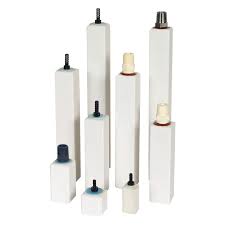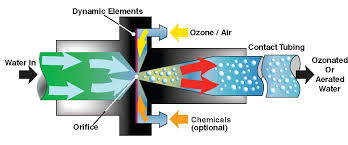Ozone Injection Process
Ozone injection/oxidation. The injection of the ozone into the water produces tiny ozone bubbles, which saturate every drop of water. At this point, oxidation of iron, sulfur and manganese is immediate. Ozone must be injected into the water after it is produced.
There are 3 methods that are most commonly used:
1) Ozone Pump - a positive displacement injector that pumps the ozone gas into the water similar to a chemical feed pump for chlorine;
2) Venturi - device that restricts flow and pressure in order to produce a vacuum. This vacuum device sucks the ozone gas into the water. Improper sizing will result in insufficient ozone suction, which will cause insufficient oxidation.
3, Diffuser- works under pressure. A diffuser creates a bubble column. The advantages are high yield, simple construction and advantageous for high flow rates (i.e drinking water systems). Disadvantages are the limited volume to be treated, required surface area and the need of tall tank to increase the efficiency.
After O3 gas injection 2 more important steps to be taken
A - aeration. The elimination (off gassing or venting) of the ozone and other gases/odors, such as sulfur, occurs by an ozone stripping action. As water flows down the Off Gas Tank, ozonated water rises and strips any gassing the incoming water.
B - filtration. The final step for removing the oxidized material is filtration. The media used should have: low water waste (backwash), high service flow, high removal capacity and requires no chemicals during regeneration. Mechanical filtration is all that is necessary if proper oxidation has been achieved.
Ozone Pump vs. Venturi
There are only two possible and practical methods for injecting ozone into the water—Ozone Pump or Venturi. Both have advantages and disadvantages.
Ozone Pump. It is a positive displacement injector that pumps the ozone gas into the water, which is similar to a chemical feed pump for chlorine. There is no restriction of flow or pressure and it achieves the greatest volume of gas injection. This is an important factor when dealing with iron and sulfur over 3 ppm.
Venturi. This vacuum device pulls the ozone gas into the water. The exact gpm (gallon per minute) flow rate and operating recovery pressure must be established before selecting the correct Venturi. Improper sizing will result in insufficient ozone suction, which will cause insufficient oxidation and result in carry-over of what you are trying to remove. Not oxidized iron, sulfur, or manganese can not be removed! Booster pumps can be added to increase the pressure prior to the Venturi to futher increasing effectiveness.
Plus - Venturi. They are low cost, have no moving parts, and require little or no maintenance.
Minus - Venturi. It is critical to size the venturi correctly according to the gpm and psi. Incorrect sizing will result in insufficient ozone injection. The venturi must be installed in specific locations, which is close to the pump and prior to the pressure tank. Installing in the wrong location will cause the venturi to not create the proper suction. Pressure and water volume loss is typical and can be extreme. Booster pumps are needed quite often depending upon the hydraulics of the system.
Plus - Ozone Pump. Ozone Pumps can accomplish injection in any location. They inject high concentrations of micro-bubbles based upon Henry’s Law of Physics. The benefit is the ease of installation, sizing, higher volume of gas injected, and no restriction of flow or pressure. The Ozone Pump eliminates possible improper sizing and restrictions associated with Venturi and can inject 2.5 to 4 times more gas by volume.
Minus- Ozone Pump. Cost, moving parts and periodic service. The frequency of service will depend upon the operating time and the environmental conditions.

